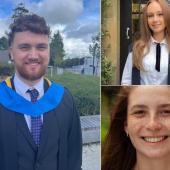We use precision control of atoms and light to explore and exploit the quantum realm. Our research includes many-body quantum physics with ultracold atoms, atom interferometers for gravitational wave detection, and cavity-QED for enhanced light-matter coupling.
The remarkable ability to cool atoms with laser light provides experimental access to a vast array of quantum physics. On the one hand, it has allowed the very detailed study of Bose-Einstein condensation and other more intricate many-body quantum phenomena. On the other hand, it has led to the manipulation of atoms with photons on the single particle level, for example in high finesse optical cavities.
Many-body quantum physics with ultracold atoms
We use atoms cooled into the quantum degenerate regime to study a range of quantum many-body phenomena. The dipolar quantum gases group led by Rob Smith cool highly magnetic erbium atoms to study the effect of long-range interactions on range of phenomena from supersolidity, to turbulence, to impurity physics and open quantum systems. The ultracold quantum matter group led by Chris Foot explores many-body physics such as non-equilibrium dynamics in 2D quantum gases and has developed cold-atom sources for large-scale atom interferometers (see below).
The theory of quantum systems group led by Andrew Daley work on out of equilibrium properties of quantum gases and of dissipative open systems, and have a particular interest in systems with long-range interactions. Their work connects to experiments with atoms and molecules in optical lattices, tweezers and cavities, as well as trapped ions, and also links to modern solid-state physics experiments.
The quantum systems engineering group led by Dieter Jaksch are theoretically exploring a range of topics in this area from the dynamics of driven systems to dipolar interactions to dissipation and open quantum systems.
Many related theoretical studies are also carried out under the fields, strings and quantum dynamics theme.
Atom interferometer
The Atom Interferometer Observatory and Network (AION), starting in 2021, is developing large-scale atom interferometers based on laser-cooled strontium atoms in an atomic fountain. This will enhance the sensitivity of searches for dark matter and provide a pathway towards detecting the gravitational waves in the mid-frequency range (from sources that are not detectable with current technology). The atomic and laser physics aspects of this collaborative project, in Oxford, are led by Chris Foot and Elliot Bentine. Others involved in this large-scale project are in Particle Physics and Theoretical Physics as well as collaboration with six other UK institutions in the Quantum Technology for Fundamental Physics programme. The instrument will form part of a network of atom interferometers, in particular with MAGIS-100 in the US.
Cavity-QED
The interaction of atoms with light, enhanced via coupling to optical cavities, is both an area of fundamental interest and also crucially important for quantum communication and information. The activities of the atom-photon connection group led by Axel Kuhn focus on the ultimate control of atom-photon interactions at the single-atom and single-photon level.
The enhanced coupling of light to matter using optical cavities can also lead to cavity induced interactions and new dynamical phases of matter; these topics are explored by quantum systems engineering group led by Dieter Jaksch and also by Andrea Cavalleri.
Quantum fundamentals
The Frontiers of Quantum Physics group led by Vlatko Vedral explore the application of quantum physics in the domain of large systems. They use techniques from information theory, thermodynamics and many-body physics to bridge the gap between the micro and macro worlds, both theoretically and experimentally.


